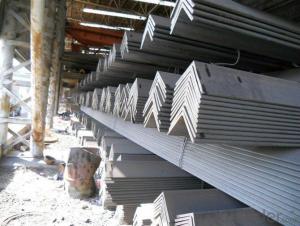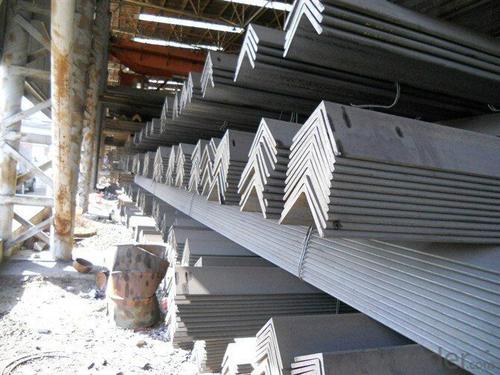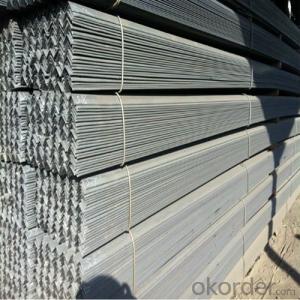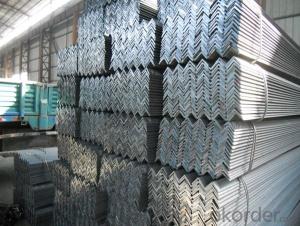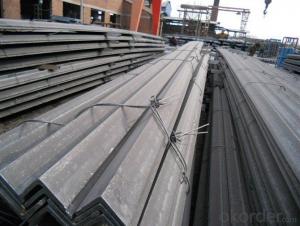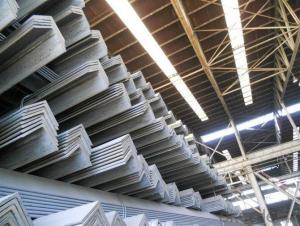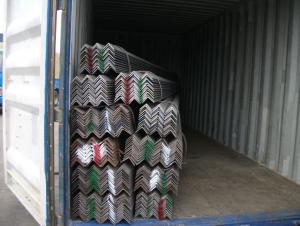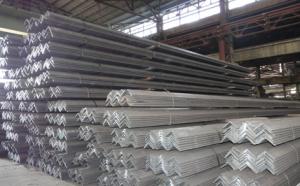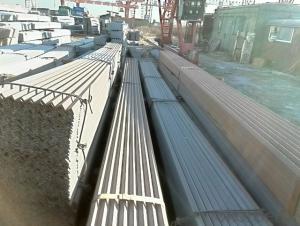2015 Hot Rolled Angle Steel in Construction
- Loading Port:
- Tianjin
- Payment Terms:
- TT OR LC
- Min Order Qty:
- 25 m.t.
- Supply Capability:
- 20000 m.t./month
OKorder Service Pledge
OKorder Financial Service
You Might Also Like
Specification
OKorder is offering high quality Hot Rolled Steel Angle at great prices with worldwide shipping. Our supplier is a world-class manufacturer of steel, with our products utilized the world over. OKorder annually supplies products to European, North American and Asian markets. We provide quotations within 24 hours of receiving an inquiry and guarantee competitive prices.
Product Applications:
Hot Rolled Steel Angles are ideal for structural applications and are widely used in the construction of buildings and bridges, and the manufacturing, petrochemical, and transportation industries.
Product Advantages:
OKorder's Steel Angles are durable, strong, and resist corrosion.
Main Product Features:
· Premium quality
· Prompt delivery & seaworthy packing (30 days after receiving deposit)
· Corrosion resistance
· Can be recycled and reused
· Mill test certification
· Professional Service
· Competitive pricing
Product Specifications:
Manufacture: Hot rolled
Grade: Q195 – 235
Certificates: ISO, SGS, BV, CIQ
Length: 6m – 12m, as per customer request
Packaging: Export packing, nude packing, bundled
Sizes: 25mm-250mm | ||
a*t | ||
25*2.5-4.0 | 70*6.0-9.0 | 130*9.0-15 |
30*2.5-6.6 | 75*6.0-9.0 | 140*10-14 |
36*3.0-5.0 | 80*5.0-10 | 150*10-20 |
38*2.3-6.0 | 90*7.0-10 | 160*10-16 |
40*3.0-5.0 | 100*6.0-12 | 175*12-15 |
45*4.0-6.0 | 110*8.0-10 | 180*12-18 |
50*4.0-6.0 | 120*6.0-15 | 200*14-25 |
60*4.0-8.0 | 125*8.0-14 | 250*25 |
FAQ:
Q1: Why buy Materials & Equipment from OKorder.com?
A1: All products offered byOKorder.com are carefully selected from China's most reliable manufacturing enterprises. Through its ISO certifications, OKorder.com adheres to the highest standards and a commitment to supply chain safety and customer satisfaction.
Q2: How do we guarantee the quality of our products?
A2: We have established an advanced quality management system which conducts strict quality tests at every step, from raw materials to the final product. At the same time, we provide extensive follow-up service assurances as required.
Q3: How soon can we receive the product after purchase?
A3: Within three days of placing an order, we will begin production. The specific shipping date is dependent upon international and government factors, but is typically 7 to 10 workdays.
Alloy No | Grade | Element (%) | ||||
C | Mn | S | P | Si | ||
Q235 | B | 0.12—0.20 | 0.3—0.7 | ≤0.045 | ≤0.045 | ≤0.3 |
Alloy No | Grade | Yielding strength point( Mpa) | ||||
Thickness (mm) | ||||||
≤16 | >16--40 | >40--60 | >60--100 | |||
≥ | ||||||
Q235 | B | 235 | 225 | 215 | 205 | |
Alloy No | Grade | Tensile strength (Mpa) | Elongation after fracture (%) | |||
Thickness (mm) | ||||||
≤16 | >16--40 | >40--60 | >60--100 | |||
≥ | ||||||
Q235 | B | 375--500 | 26 | 25 | 24 | 23 |
Images:

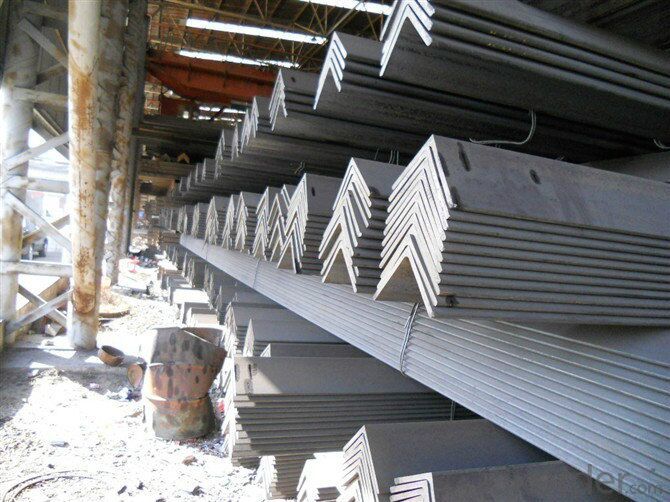
- Q: How do steel angles contribute to the overall torsional stiffness of a structure?
- Steel angles contribute to the overall torsional stiffness of a structure by providing resistance against torsional forces. The angled shape of the steel members helps to distribute and transfer these forces, preventing excessive twisting or rotation of the structure. This added stiffness helps to maintain structural integrity and stability, ensuring that the structure can withstand torsional loads and maintain its desired shape.
- Q: How do steel angles perform in terms of vibration resistance?
- Due to their robust and inflexible structure, steel angles generally exhibit excellent vibration resistance. The L-shaped configuration of a steel angle not only enhances its strength and stability but also grants it heightened resistance to vibrations. When utilized in construction or engineering endeavors, steel angles effectively absorb and mitigate vibrations, thereby minimizing the potential for structural damage or failure. The rigidity and notable tensile strength of steel angles enable them to withstand dynamic loads and vibrations stemming from diverse factors, such as wind, earthquakes, or machinery operations. They proficiently distribute and dissipate vibrational forces throughout their structure, averting excessive movement or oscillation. This proves particularly pivotal in applications requiring steadfastness and longevity, such as in the construction of bridges, buildings, or industrial equipment. Furthermore, steel angles can be tailored and fabricated to meet precise vibration resistance specifications. By selecting suitable steel grades and dimensions, engineers can optimize the performance of steel angles in terms of vibration resistance. They also possess the ability to incorporate supplementary characteristics like stiffeners or reinforcements, further augmenting the vibration resistance of steel angle structures. Collectively, steel angles have demonstrated their dependability and effectiveness in withstanding vibrations, rendering them a favored choice across a multitude of industries and applications where upholding structural integrity is of paramount importance.
- Q: Can steel angles be bent or formed?
- Certainly, it is possible to bend or form steel angles. Steel angles are frequently utilized as structural components, crafted from steel and boasting an L-shaped cross-section. There are multiple techniques available for bending or forming them, including hot or cold bending, rolling, or press-braking. The selection of a specific method hinges on factors like the desired angle, bending radius, as well as the thickness and type of steel employed. By bending or forming steel angles, one can fabricate diverse shapes and angles to meet precise structural or design criteria.
- Q: How do steel angles perform in terms of sound reflection or absorption?
- Steel angles are typically used in construction and engineering applications where their primary purpose is to provide structural support and stability. In terms of sound reflection or absorption, steel angles do not have any significant effect. Due to their dense and rigid nature, steel angles tend to reflect sound rather than absorb it. This means that when sound waves encounter a steel angle, they bounce off its surface and continue to propagate in the surrounding environment. As a result, steel angles are not generally relied upon for soundproofing purposes. To effectively control sound reflection or absorption, alternative materials with sound-dampening properties, such as acoustic panels, insulation, or specialized soundproofing materials, are typically used. These materials are designed to absorb sound waves and minimize their reflection, resulting in a quieter and more controlled acoustic environment. In summary, steel angles are not effective in terms of sound reflection or absorption due to their rigid and reflective nature. Alternative materials should be considered for soundproofing purposes in order to achieve the desired acoustic performance.
- Q: Are steel angles suitable for manufacturing structural beams?
- Indeed, structural beams can be manufactured using steel angles. These L-shaped structural steel components, widely recognized as steel angles, are frequently employed in the construction sector for the purpose of constructing structural beams owing to their durability and adaptability. Steel angles possess exceptional load-bearing capabilities and can withstand substantial loads and forces, thus making them perfect for erecting beams capable of supporting the weight of buildings, bridges, and other structures. Moreover, steel angles can be easily joined together through welding, bolting, or other means to create larger structural elements, thereby providing flexibility in terms of design and construction. All in all, steel angles are a dependable and effective option when it comes to producing structural beams.
- Q: What is the maximum allowable compressive stress for a steel angle?
- The maximum allowable compressive stress for a steel angle depends on various factors such as the type of steel, its dimensions, and the specific design and safety codes being followed. It is recommended to refer to the relevant structural engineering guidelines, codes, or specifications to determine the exact maximum allowable compressive stress for a steel angle in a particular application.
- Q: Can steel angles be drilled or punched for fastening?
- Yes, steel angles can be drilled or punched for fastening. Steel angles are commonly used in construction and manufacturing industries for their structural strength and versatility. When it comes to attaching steel angles to other materials or fastening them together, drilling or punching holes is a common method. Drilling is the process of creating holes in steel angles using a drill bit. This allows for precise placement of holes and is suitable for applications where the angle needs to be attached to a specific location. Drilling can be done manually or with the help of drilling machines, depending on the scale of the project. Punching, on the other hand, involves using a punch and die set to create holes in steel angles. This method is faster and more efficient than drilling, especially when dealing with large quantities of angles. Punching machines can create holes of various sizes and shapes, making it suitable for different fastening requirements. Once the holes are drilled or punched, fastening can be done using bolts, screws, or rivets. These fasteners are inserted through the holes and tightened to securely hold the steel angles together or attach them to other materials. The choice of fastening method depends on the specific application and load requirements. In summary, steel angles can indeed be drilled or punched for fastening. Whether it's for attaching steel angles to other materials or joining them together, drilling or punching holes provides the necessary means for secure and reliable fastening in various construction and manufacturing projects.
- Q: What are the different types of steel angles connections?
- There are several types of steel angle connections, including bolted connections, welded connections, and hybrid connections. Bolted connections use bolts and nuts to join the steel angles together, providing flexibility for disassembly and reassembly. Welded connections involve fusing the steel angles together using heat, creating a strong and permanent connection. Hybrid connections combine both bolted and welded connections, utilizing the benefits of each method for optimal strength and convenience.
- Q: How do you calculate the torsional strength of a steel angle?
- In order to calculate the torsional strength of a steel angle, several factors must be considered. First and foremost, it is crucial to determine the moment of inertia of the steel angle's cross-section. This can be achieved by utilizing the formula for the moment of inertia of a rectangular shape, namely (b * h^3)/12. Here, b represents the base width and h stands for the angle's height. Once the moment of inertia is established, it becomes possible to calculate the maximum shear stress using the equation T = (M * c)/I. In this formula, T signifies the torsional strength, M denotes the applied torque, c represents the distance from the centroid of the angle to the outermost fiber, and I symbolizes the moment of inertia. Determining the maximum allowable shear stress for the steel angle is achievable by taking into account the material properties of the steel. This value can be retrieved from engineering handbooks or specifications. Lastly, the torsional strength of the steel angle can be calculated by multiplying the maximum allowable shear stress by the moment of inertia of the angle. It is important to note that this calculation assumes the steel angle is only subjected to pure torsion, without any bending or additional external loads. If the angle is exposed to combined loads, more intricate calculations may be necessary to determine the torsional strength.
- Q: How do you prevent steel angles from twisting?
- There are several methods that can be employed to prevent steel angles from twisting: 1. Proper fabrication techniques: Ensure that the steel angles are fabricated accurately and precisely, with straight and square cuts. This will help maintain the structural integrity of the angles and prevent them from twisting. 2. Bracing and supports: Use appropriate bracing and supports during the installation process to provide stability to the steel angles. These can include temporary supports, diagonal bracing, or cross bracing, depending on the specific application. 3. Welding techniques: When joining steel angles together, use proper welding techniques to minimize distortion and twisting. This includes using the correct welding process, ensuring proper heat control, and employing suitable fixturing to hold the angles in place during the welding process. 4. Anchoring methods: Depending on the specific application, anchoring methods such as bolting, screwing, or welding the steel angles to other structural elements can help prevent twisting. These anchoring methods provide additional stability and prevent the angles from rotating or twisting under external forces. 5. Regular inspections and maintenance: Conduct regular inspections to identify any signs of twisting or distortion in the steel angles. If any issues are detected, take immediate corrective action to rectify the problem and prevent further twisting. Overall, a combination of accurate fabrication, proper bracing and supports, appropriate welding techniques, anchoring methods, and regular maintenance can effectively prevent steel angles from twisting and ensure their structural stability.
Send your message to us
2015 Hot Rolled Angle Steel in Construction
- Loading Port:
- Tianjin
- Payment Terms:
- TT OR LC
- Min Order Qty:
- 25 m.t.
- Supply Capability:
- 20000 m.t./month
OKorder Service Pledge
OKorder Financial Service
Similar products
Hot products
Hot Searches
Related keywords
